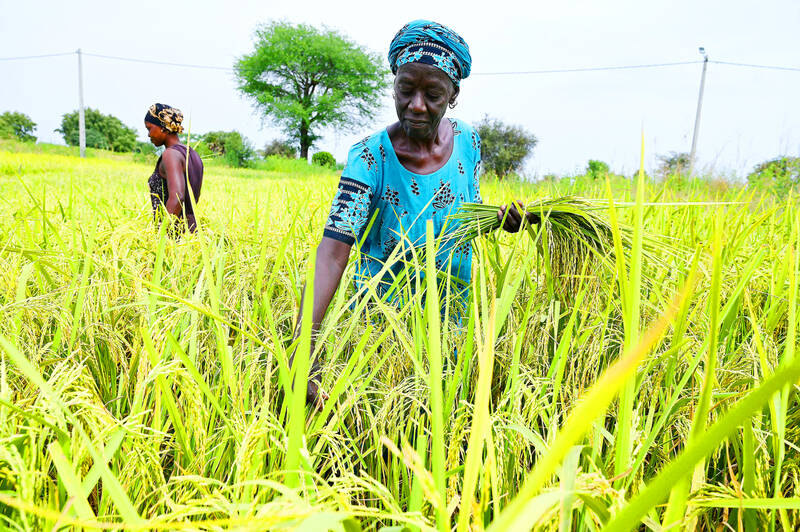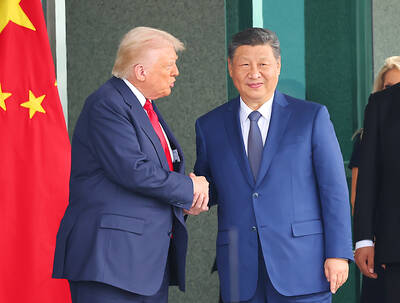Outside Dak village in central Senegal women sing and dance as they chop through rice stalks with sickle or knife. The harvest is under way in the west African nation, but there will not be enough for everyone.
Many African countries depend on imports, and the market has been roiled by restrictions imposed in September by India.
In a bid to control domestic prices affected by a crippling drought, the leading global rice exporter banned exports of broken rice and slapped a 20 percent export tax on some non-basmati varieties.

Photo: AFP
In several African countries that rely on imported rice, self-sufficiency has become a buzzword.
“The risk [of a rice shortage] in Senegal is for real,” said Waly Diouf, coordinator of a program aimed at ending foreign dependence on the staple.
“We don’t want to buy imported rice anymore, it’s very expensive,” said Dieteo Diouf, who runs a women’s association at Dak, in the central region of Fatick.
Fish and rice, or ceebu jen in the Wolof language, is the most popular dish in Senegal and UNESCO has even put it on the list of humanity’s intangible cultural heritage.
Rice became a major staple after French colonialists seeking a new outlet shipped it from Indochina during the 19th century, to the detriment of local subsistence farming.
Africa accounts for 13 percent of the world population, but 32 percent of global rice imports, said Africa Rice, a research center set up by 28 nations and based in Abidjan.
“Local rice production covers only about 60 percent of current demand in sub-Saharan Africa, which means 14 to 15 million tonnes are imported annually,” the center said.
India’s move to restrict exports caused panic in several countries, notably the Indian Ocean Comoro Islands. One-quarter of its 890,000 people live under the poverty line of two euros a day per person.
Clashes broke out at the end of September as the price of a 25kg sack of rice rose by almost one-third.
On the east coast of the continent in Liberia, which also experiences intense poverty, big queues formed outside wholesalers as rumors spread of rice shortages.
That helped lift the price of a sack from just under US$14 euros (US$14.83) to more than US$24 in Liberia, and saw the government issue a call for calm.
The Senegalese government recently intervened and fixed the price of 1kg of Indian and Pakistani broken rice at 0.50 euros to avoid panic and try to halt speculation.
Broken rice is one of the cheapest available and almost the only one imported into Senegal, Diouf said.
In 2008, the country experienced “hunger riots” over the spiraling cost of food.
Over the past few years Senegal has grown about 840,000 tonnes of rice annually, or about nine months of local consumption, Diouf said.
The country “imports on average 900,000 tonnes of rice. That is more than is needed, but the imports keep the product available and avoid speculation,” he added.
The aim is to reduce dependency on imports, mainly by increasing acreage under production.
“By 2030, rice consumption in Senegal is expected to reach 1.5 million tonnes,” Diouf said.
“We have worked out a new strategy to move toward self-sufficiency. Financially it will cost around 1.37 billion FCFA [CFA franc] (US$2.2 million),” he said.
Others say that many obstacles have to be overcome to meet this often-declared goal of self-sufficiency.
“We need more rice field areas, more credit, more combine harvesters; we need to rebuild our irrigation systems,” said Mouhamadou Moustapha Diack, who heads the producers’ union at Boundoum in the north.
The old dykes and water channels between the paddy fields are covered in lilies and eucalyptus.
Aside from quantity, the supposed lower quality rice grown in Senegal has for a long time put off some local consumers.
“That’s changed,” stated Birame Diouf, who runs a rice factory at Ross Bethio, in the north.
The plant removes impurities such as grit and tiny stones before the rice grains are swallowed up by huge cleaning tanks and transformed into whole or broken grains ready for cooking.
Senegal is hoping to follow the example of Ivory Coast where rice imports from India fell 24 percent from last year to this year.
Ivory Coast’s rice development agency Aderiz has reported “clear progress” in substituting Ivorian rice for foreign imports.
Meanwhile, Nigeria has followed a different strategy and slapped heavy taxes on imported rice to try to boost local production.
Other commodities:
‧?Gold for February delivery rose US$12.40 to US$1,800.20 an ounce, dropping 0.58 percent from a week earlier.
‧?Silver for March delivery rose US$0.02 to US$23.33 an ounce, down 1.64 percent weekly.
‧?March copperwas unchanged at US$3.76 a pound, but lost 3.09 percent on the week.
Additional reporting by AP

RUN IT BACK: A succesful first project working with hyperscalers to design chips encouraged MediaTek to start a second project, aiming to hit stride in 2028 MediaTek Inc (聯發科), the world’s biggest smartphone chip supplier, yesterday said it is engaging a second hyperscaler to help design artificial intelligence (AI) accelerators used in data centers following a similar project expected to generate revenue streams soon. The first AI accelerator project is to bring in US$1 billion revenue next year and several billion US dollars more in 2027, MediaTek chief executive officer Rick Tsai (蔡力行) told a virtual investor conference yesterday. The second AI accelerator project is expected to contribute to revenue beginning in 2028, Tsai said. MediaTek yesterday raised its revenue forecast for the global AI accelerator used

Taiwan Semiconductor Manufacturing Co (TSMC, 台積電) has secured three construction permits for its plan to build a state-of-the-art A14 wafer fab in Taichung, and is likely to start construction soon, the Central Taiwan Science Park Bureau said yesterday. Speaking with CNA, Wang Chun-chieh (王俊傑), deputy director general of the science park bureau, said the world’s largest contract chipmaker has received three construction permits — one to build a fab to roll out sophisticated chips, another to build a central utility plant to provide water and electricity for the facility and the other to build three office buildings. With the three permits, TSMC

The DBS Foundation yesterday announced the launch of two flagship programs, “Silver Motion” and “Happier Caregiver, Healthier Seniors,” in partnership with CCILU Ltd, Hondao Senior Citizens’ Welfare Foundation and the Garden of Hope Foundation to help Taiwan face the challenges of a rapidly aging population. The foundation said it would invest S$4.91 million (US$3.8 million) over three years to foster inclusion and resilience in an aging society. “Aging may bring challenges, but it also brings opportunities. With many Asian markets rapidly becoming super-aged, the DBS Foundation is working with a regional ecosystem of like-minded partners across the private, public and people sectors

TEMPORARY TRUCE: China has made concessions to ease rare earth trade controls, among others, while Washington holds fire on a 100% tariff on all Chinese goods China is effectively suspending implementation of additional export controls on rare earth metals and terminating investigations targeting US companies in the semiconductor supply chain, the White House announced. The White House on Saturday issued a fact sheet outlining some details of the trade pact agreed to earlier in the week by US President Donald Trump and Chinese President Xi Jinping (習近平) that aimed to ease tensions between the world’s two largest economies. Under the deal, China is to issue general licenses valid for exports of rare earths, gallium, germanium, antimony and graphite “for the benefit of US end users and their suppliers